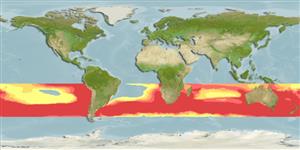Allothunnus fallai Serventy, 1948
Slender tuna
Beobachtung melden im Fish Watcher
| Native range | All suitable habitat | Point map | Year 2050 |

|
| This map was computer-generated and has not yet been reviewed. |
| Allothunnus fallai AquaMaps Data sources: GBIF OBIS |
Hochladen Photos und videos
Pictures | Google BildAllothunnus fallai
Picture by FAO
Pictures | Google BildAllothunnus fallai
Picture by FAO
Common names from other countries
Klassifizierung / Names Namen | Synonyme | Catalog of Fishes(Gattung, Arten) | ITIS | CoL | WoRMS | Cloffa
> Scombriformes (Mackerels) > Scombridae (Mackerels, tunas, bonitos) > Scombrinae
Etymology: Allothunnus: Greek, allos = other + Greek, thynnos = tunna (Ref. 45335).
Etymology: Allothunnus: Greek, allos = other + Greek, thynnos = tunna (Ref. 45335).
Environment: milieu / climate zone / depth range / distribution range Ökologie
seewasser; ozeanodrom (Ref. 51243); tiefenbereich 0 - 20 m (Ref. 86942). Subtropical; 10°S - 50°S, 180°W - 180°E (Ref. 168)
Verbreitung Länder | FAO Gebiete | Ecosystems | Vorkommen | Point map | Einführungen | Faunafri
Southern Ocean: circumglobal. One individual taken in Los Angeles Harbor.
Size / Gewicht / Alter
Maturity: Lm ? range ? - ? cm
Max length : 105 cm FL Männchen/unbestimmt; (Ref. 5313); common length : 86.0 cm TL Männchen/unbestimmt; (Ref. 9684); max. veröff. Gewicht: 13.7 kg (Ref. 5313)
Max length : 105 cm FL Männchen/unbestimmt; (Ref. 5313); common length : 86.0 cm TL Männchen/unbestimmt; (Ref. 9684); max. veröff. Gewicht: 13.7 kg (Ref. 5313)
Kurzbeschreibung Bestimmungsschlüssel | Morphologie | Morphometrie
Rückenflossenstacheln (insgesamt) : 15 - 18; Rückenflossenweichstrahlen (insgesamt) : 12 - 13; Afterflossenstacheln: 0; Afterflossenweichstrahlen: 13 - 14; Wirbelzahl: 40. Interpelvic process small and bifid. Body naked ventrally behind the long anterior corselet. Dorsal half of body to lateral line covered with scales. Swim bladder absent. The back is bluish, turning to deep purple or almost black on the head; the belly is white, without stripes or spots; the pectoral and pelvic fins purple, their inner sides black.
An occasionally schooling species which feeds mainly on krill (euphausiids), and also on squids and small fishes. Juveniles are found between 20 and 35°S at surface temperatures ranging from 19 to 24°C. Its flesh is paler than that of most true tunas and is very oily, but the cooked meat has fine eating qualities. Mainly marketed fresh.
Life cycle and mating behavior Geschlechtsreife | Fortpflanzung | Ablaichen | Eier | Fecundity | Larven
Hauptreferenz
Upload your references | Referenzen | Koordinator : Collette, Bruce B. | Partner
Collette, B.B. and C.E. Nauen, 1983. FAO Species Catalogue. Vol. 2. Scombrids of the world. An annotated and illustrated catalogue of tunas, mackerels, bonitos and related species known to date. Rome: FAO. FAO Fish. Synop. 125(2):137 p. (Ref. 168)
IUCN Rote Liste Status (Ref. 130435: Version 2024-1)
nicht bedroht (LC) ; Date assessed: 01 March 2022
Bedrohung für Menschen
Harmless
Nutzung durch Menschen
Fischereien: weniger kommerziell; Sportfisch: ja
FAO(Fischereien: production; publication : search) | FIRMS (Stock assessments) | FishSource | Sea Around Us
Mehr Information
Population dynamics
Growth parameters
Max. ages / sizes
Length-weight rel.
Length-length rel.
Längenhäufigkeiten
Mass conversion
Rekrutierung
Dichte
Growth parameters
Max. ages / sizes
Length-weight rel.
Length-length rel.
Längenhäufigkeiten
Mass conversion
Rekrutierung
Dichte
Life cycle
Fortpflanzung
Geschlechtsreife
Fecundity
Ablaichen
Spawning aggregations
Eier
Eientwicklung
Larven
Larven Pop.Dyn.
Fortpflanzung
Geschlechtsreife
Fecundity
Ablaichen
Spawning aggregations
Eier
Eientwicklung
Larven
Larven Pop.Dyn.
Anatomy
Kiemenoberfläche
Brain
Otolith
Kiemenoberfläche
Brain
Otolith
Physiology
Body composition
Nutrients
Oxygen consumption
Swimming type
Swimming speed
Visual pigments
Fish sound
Diseases & Parasites
Toxicity (LC50s)
Body composition
Nutrients
Oxygen consumption
Swimming type
Swimming speed
Visual pigments
Fish sound
Diseases & Parasites
Toxicity (LC50s)
Genetics
Genetik
Heterozygosity
Vererbbarkeit
Genetik
Heterozygosity
Vererbbarkeit
Human related
Aquaculture systems
Aquakultur Profile
Zuchtlinien
Ciguatera cases
Stamps, coins, misc.
Aquaculture systems
Aquakultur Profile
Zuchtlinien
Ciguatera cases
Stamps, coins, misc.
Tools
E-book | Feldführer | Bestimmungsschlüssel | Längenhäufigkeits Tool | Lebensdaten Tool | Punkt Karte | Classification Tree
| Catch-MSY |
Zusatzinformationen
Download XML
Zusammenfassung | Point data | Namen | Photos
Internet Quellen
Aquatic Commons | BHL | Cloffa | BOLDSystems | Websites from users | FishWatcher Einträge suchen | CISTI | Catalog of Fishes(Gattung, Arten) | DiscoverLife | ECOTOX | Faunafri | Fishtrace | GenBank(Genom, nucleotide) | GloBI | GOBASE | | Google Books | Google Scholar | Google | IGFA World Record | MitoFish | Nationale Datenbanken | Otolith Atlas of Taiwan Fishes | PubMed | Reef Life Survey | Scirus | SeaLifeBase | Tree of Life | Wikipedia(Gehe zu, Suchen) | World Records Freshwater Fishing | Zoobank | Zoological Record
Estimates based on models
Preferred temperature (Ref. 115969): 15.8 - 24.6, mean 18.4 (based on 182 cells).
Phylogenetic diversity index (Ref. 82804): PD50 = 1.0000 [Uniqueness, from 0.5 = low to 2.0 = high].
Bayesian length-weight: a=0.00955 (0.00460 - 0.01984), b=3.06 (2.89 - 3.23), in cm Total Length, based on LWR estimates for this (Sub)family-body shape (Ref. 93245).
Trophic level (Ref. 69278): 3.7 ±0.1 se; based on diet studies.
Widerstandsfähigkeit (Ref. 120179): mittel, Verdopplung der Population dauert 1,4 - 4,4 Jahre. (Preliminary K or Fecundity.).
Fishing Vulnerability (Ref. 59153): High to very high vulnerability (70 of 100).




